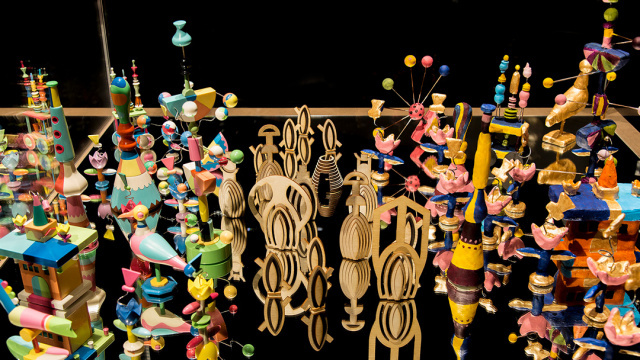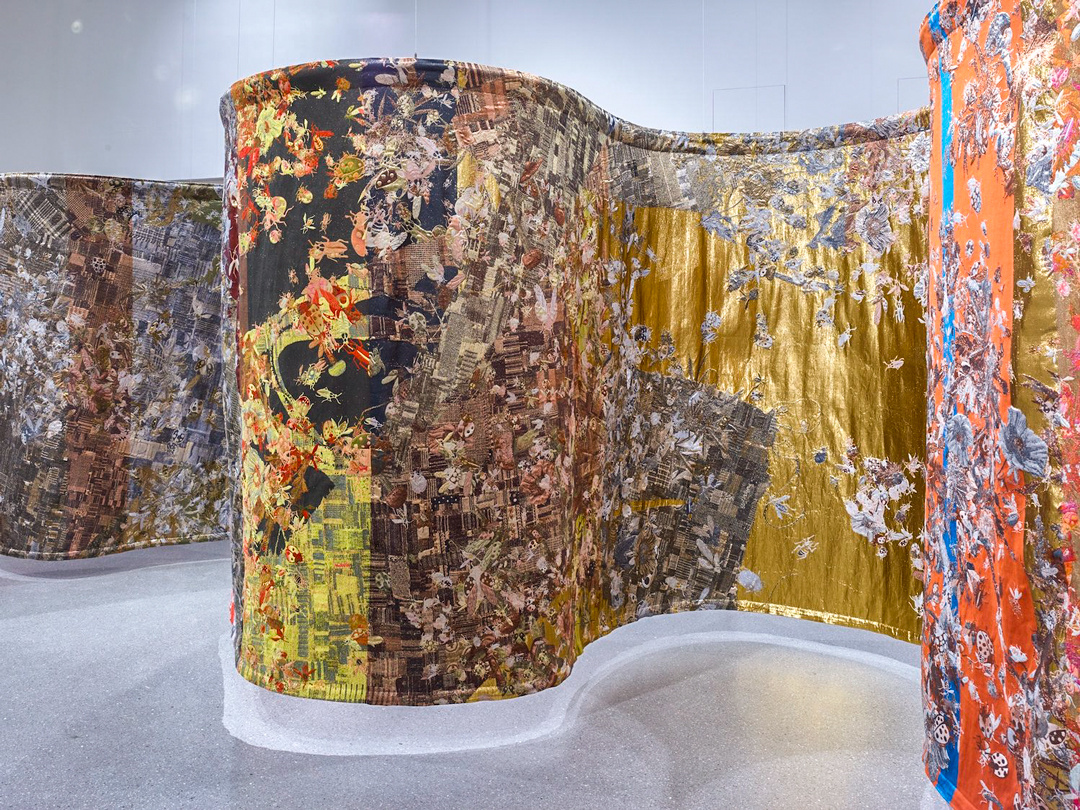The sixth installment of the San José Museum of Art (SJMA)’s exhibition series “Beta Space” presents a compendium of new and recent work by internationally renowned artist Pae White. The exhibition features three new immense paper clay paintings; a dramatic new silk-screened electroplated steel mobile; a series of delicate cotton and rayon letters and numbers handstitched on paper; and two massive installations making their US debut: a 127-foot long tapestry woven with metallic threads and a chess set comprised of over 100 toys fashioned from glass, wood, clay, porcelain, plastic, acrylic, and rubber. Beta Space: Pae White opens on Thursday, July 18, 2019, 5–9pm through January 19, 2020.
“The work of Los Angeles-based artist Pae White transcends nearly all traditional boundaries—between art and design, craft and fine art, architecture and installation, theory and practice,” said S. Sayre Batton, Oshman Executive Director at SJMA. “White’s practice across various media and disciplines captures the spirit of the ‘Beta Space’ series: her work brims with artistic risk-taking and experimentation—qualities that resonate with the wildly creative and innovative ethos of Silicon Valley.”
Beta Space: Pae White features both her monumental installations and newly created works of art that will transform the gallery and encourage visitors to rethink how they move through space and to reflect on everyday objects, materials, and phenomena. Shifting our associations and ideas regarding architecture and conventional museum display practices, White’s work, which often features elements of traditional craft merged with digital practices, shares and allows room for different types of workmanship that are often overlooked within the walls of a museum.
“White’s art is always kinaesthetic—as much a bodily as visual experience that plays with the senses,” said Rory Padeken, SJMA associate curator and curator of the exhibition. “Her work is as alluring as it is ambiguous, suggesting that things may not be as they may seem. The handmade nature of her work, combined with sophisticated technologies and inventive processes, allows for a high degree of improvisation.”
The centerpiece of the exhibition is foreverago (2017), the artist’s largest tapestry to date at 127 feet long. Shown in the United States for the first time, it will meander through the gallery, creating a sinuous wall-like structure that presents both the front and back of the weaving. Revolutionizing the genre of tapestry for the 21st century, White relied on the help of skilled artisans while employing advanced digital imaging techniques to weave together colorful cotton, cashmere, and metallic threads, and used custom software that randomizes distribution patterns to produce her seemingly chaotic scene. Part of the artist’s ongoing series “Bugz + Drugs,” foreverago explodes with a cacophony of insects—ladybugs, dragonflies, grasshoppers, and crickets—descending on mushrooms, poppies, and cannabis—plants known for their psychoactive, calming effects. Renderings of antique Japanese kimono fabric samples and Byzantine icons further enhance an already rich and visually abundant composition.
About Pae White
Born in 1963 in Pasadena, California, Los Angeles-based artist Pae White received her BA from Scripps College, Claremont, California in 1985 and MFA from Art Center College of Design, Pasadena in 1991. She received a City of Los Angeles (COLA) Fellowship in 2003 and a Getty Mid-career Fellowship in 2009. Her solo exhibitions include Saarland Museum, Germany (2017); Le Stanze del Vetro, Venice, Italy (2017); Henry Art Gallery, Seattle (2015); Fabric Workshop and Museum, Philadelphia (2012); Art Institute of Chicago (2011); Saint Louis Art Museum, Missouri (2010); Scottsdale Museum of Contemporary Art, Arizona (2008); Hirshhorn Museum and Sculpture Garden, Washington, DC (2007); and Hammer Museum, Los Angeles (2004). Her public art projects include Metro Rapid Line, Los Angeles County; Oslo Opera House, Norway; and Tom Bradley International Terminal at Los Angeles International Airport. Contributions to publication design include Extreme Abstraction (2005); Ex-Machina, with Jorge Pardo (2002); and Jorge Pardo (1997). Her advertising projects and magazine cover designs have been featured in Art in America, Art issues, Artforum, frieze, and make. Her work is in the collections of the Hammer Museum of Art; Henry Art Gallery; Los Angeles County Museum of Art; Museum of Contemporary Art, Los Angeles; The Museum of Modern Art, New York; San Francisco Museum of Modern Art; and Tate Modern, London.
About Beta Space
The exhibition series “Beta Space” takes its cue from the legendary Silicon Valley garage: it is a work in progress, resourceful, experimental, and innovative. These projects are purposefully intended to be the opposite of exhibitions planned years in advance. “Beta Space” is a place to encourage artistic experimentation, to incubate ideas, and to foster creative opportunities as well as links within our community.
Launched in 2011, “Beta Space” addresses several priorities for SJMA: to closely connect its audiences with artists and with the artistic process; to showcase the cross-disciplinary interests of many contemporary artists; to foster timely collaborations; and to reflect the diversity and innovative spirit of Silicon Valley. “Beta Space” encourages artists to experiment and venture into new areas by creating new work commissioned by SJMA for the exhibition. Invited artists work collaboratively with the exhibition curator to develop and refine ideas and content for the exhibition.
Previous projects from the series include Ruben Ochoa and Kevin Appel (March 26–August 14, 2011); Anna Sew Hoy (August 27, 2011–February 26, 2012); Ranu Mukherjee: Telling Fortunes
(August 18, 2012–January 13, 2013); Diana Thater (March 13–September 13, 2015); and Victor Cartagena (March 17–September 4, 2017).
SJMA Celebrates 50th Anniversary
Embarking on its 50th anniversary in the fall of 2019, the San José Museum of Art launches a season of solo exhibitions of visionary women artists to honor the Museum’s history of gender parity in exhibitions, programs, acquisitions, and leadership. Undersoul: Jay DeFeo is first of the exhibitions to open, which closed July 7, 2019; Catherine Wagner: Paradox Observed opened April 5 and closes August 18, 2018; Rina Banerjee: Make Me a Summary of the World opened May 16 and is open through October 6, 2019; and Beta Space: Pae White will open July 18, 2019 and close Jan 19, 2020.
Programming
Third Thursday: Beta Space: Pae White Opening Celebration
Thu, Jul 18 | 5–9pm
Celebrate the opening of Beta Space: Pae White.
$5 after 5pm (free to SJMA Members); galleries open 5–9pm
Support
Sponsored by the Richard A. Karp Charitable Foundation, Doris and Alan Burgess, Theres and Dennis Rohan, Tad Freese and Brook Hartzell, and Mary Mocas and Marv Tseu. Additional support provided by Hildy Shandell Beville and Ross Harwood Beville, 1301PE, Los Angeles, and Roxanne Fleming and David Soward.
Supported, in part, by a Cultural Affairs grant from the City of San José.
San José Museum of Art
The San José Museum of Art reflects the diverse cultures and innovative spirit of Silicon Valley. Through its exhibitions, programs, scholarship, and collections, SJMA connects the present and the past, the art of the West Coast and the world. The Museum fosters awareness of artists’ broad contributions to society and engages audiences with the art of our time and the vitality of the creative process.
The San José Museum of Art is located at 110 South Market Street in downtown San José, California. The Museum is open Tuesday through Sunday, 11am to 5pm and until 8pm or later on the third Thursday of each month. As of Friday, February 1, 2019, SJMA is also free to all on the first Friday of each month from 5–9pm. Admission is $10 for adults, $8 for seniors, 17 and under, college students and teachers with a valid ID, and members are free. On the Third Thursday of every month, admission is reduced to $5 after 5pm. For more information, call 408.271.6840 or visit SanJoseMuseumofArt.org.
# # #
Programs at the San José Museum of Art are made possible by generous operating support from the David and Lucile Packard Foundation, Yvonne and Mike Nevens, a Cultural Affairs grant from the City of San José, and the Richard A. Karp Charitable Foundation.

